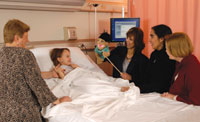The Language of International Nursing
By Mary Grace McCord
 Loreto Sepulveda (third from right) and fellow Latin American nurses worked with UAB faculty to develop innovative child and family health projects for their countries.Some parts of a nurse’s job description—compassion and skill, for example—are the same all over the world. But while nurses in the United States play an increasingly important role in both clinical care and research, their counterparts elsewhere are often still mere aides to physicians. The UAB School of Nursing is helping to change that perception through its World Health Organization/Pan-American Health Organization Collaborating Center on International Nursing. The center “teams with nurses in foreign countries to develop programs to enhance nursing education, best practices, and innovative research,” says nursing dean Doreen Harper, Ph.D., R.N., F.A.A.N.
Loreto Sepulveda (third from right) and fellow Latin American nurses worked with UAB faculty to develop innovative child and family health projects for their countries.Some parts of a nurse’s job description—compassion and skill, for example—are the same all over the world. But while nurses in the United States play an increasingly important role in both clinical care and research, their counterparts elsewhere are often still mere aides to physicians. The UAB School of Nursing is helping to change that perception through its World Health Organization/Pan-American Health Organization Collaborating Center on International Nursing. The center “teams with nurses in foreign countries to develop programs to enhance nursing education, best practices, and innovative research,” says nursing dean Doreen Harper, Ph.D., R.N., F.A.A.N.
In January, nurses from four Latin American countries traded their tropical summertime for three weeks of intense immersion in U.S.-style nursing practice at UAB. The group of professors and practitioners included eight nurses from Brazil, six from Honduras, three from Chile, and one from Colombia. During their time at UAB, the visiting nurses worked with more than a dozen mentors from the School of Nursing faculty to develop projects to improve child and family health in their home countries, including the use of telephone-based care for diabetic patients and Internet education as a catalyst to art therapy program development. Because knowledge of English is essential to international research, the visitors took part in daily classes at the UAB English Language and Culture Institute. They also interacted with School of Nursing students in a special Global Perspectives on Nursing Leadership course.
Open Arms
The success of the program was due in part to faculty and community members who opened their homes, says Lynda Wilson, Ph.D., R.N., F.A.A.N. “The gift of off-site housing brings our neighbors into the global outreach and camaraderie for which UAB is known. It’s the glue that makes possible a rich cultural exchange.”
The visitors continued their education outside the classroom. Loreto Sepulveda, a pediatric emergency nurse and nursing instructor at Universidad de Andes in Santiago, Chile, made time for shopping excursions to purchase colorful finger puppets to help comfort her young patients.
UAB students and faculty will get to take part in similar educational and cultural exchanges as part of the reciprocal agreements made through UAB’s center on international nursing, says Wilson. And a new group of visiting nurses will arrive soon: The School of Nursing plans to offer the international leadership training every two years. These exchanges are a vital part of the evolution of nursing practice worldwide, says Harper. “Our ultimate goal of ‘health for all’ involves developing and sharing educational materials and research methods to form partnerships and create a brain trust.”